speciation
Key points
- According to the biological species concept, organisms belong to the same species if they can interbreed to produce viable, fertile offspring.
- Species are separated from one another by prezygotic and postzygotic barriers, which prevent mating or the production of viable, fertile offspring.
- Speciation is the process by which new species form. It occurs when groups in a species become reproductively isolated and diverge.
- In allopatric speciation, groups from an ancestral population evolve into separate species due to a period of geographical separation.
- In sympatric speciation, groups from the same ancestral population evolve into separate species without any geographical separation.
Introduction
On some level, the idea of a species is pretty intuitive. You don't need to be a zoologist to classify organisms like humans, giant pandas, or sunflowers into groups based on their appearance. This method works well when the species in question look very different from one another. You probably wouldn’t mistake a panda for a sunflower—unless you really needed your glasses!
But when we get right down to it, what really make a species a species? Organisms that look alike often belong to the same species, but this isn’t always the case. I for one can't tell the African fish eagle and the bald eagle apart from the photos below. But they are, in fact, different species.
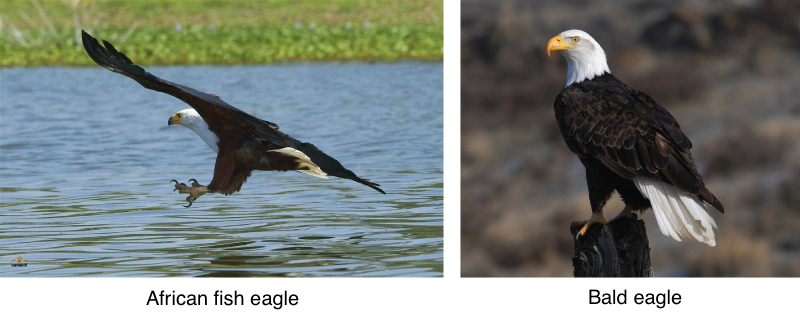
Some species appear similar to one another. For instance, the African fish eagle and bald eagle are different species that look remarkably alike.
Image credit: modified from Formation of new species: Figure 2 by OpenStax College, Biology CC BY 4.0
On the flip side, organisms that belong to the same species can look very different from one another. For instance, dogs come in all shapes and sizes—from tiny Chihuahuas to massive Great Danes—but they all belong to the same species: Canis familiaris, the domestic dog.
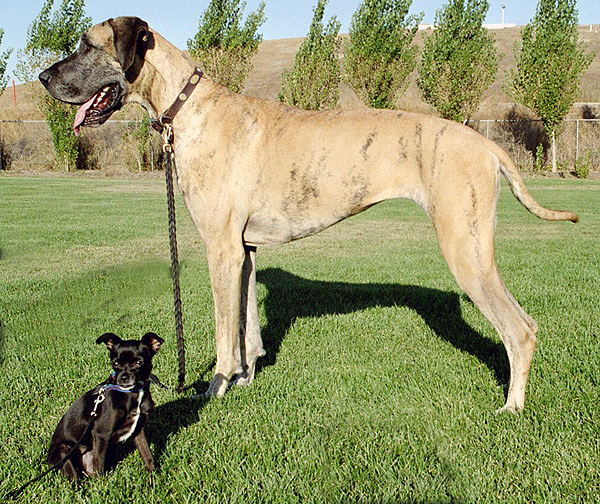
Individuals belonging to the same species can vary in their physical appearance. For example, the Great Dane and Chihuahua both belong to the same species, the domestic dog, though the former is much larger than the latter.
Image credit: Big and little dog by Ellen Levy Finch, CC BY-SA 3.0
If appearance doesn’t reliably define a species, then what does? For most eukaryotes—such as animals, plants, and fungi—scientists tend to define a species based on reproductive compatibility. That is, organisms are usually considered to be members of the same species if they can successfully reproduce with one another.
In this article, we will explore how species are defined in greater detail. We'll also look at speciation, the process by which new species arise.
The biological species concept
According to the most widely used species definition, the biological species concept, a species is a group of organisms that can potentially interbreed, or mate, with one another to produce viable, fertile offspring.
In this definition, members of the same species must have the potential to interbreed. However, that doesn't mean they have to be part of the same interbreeding group in real life. For instance, a dog living in Australia and a dog living in Africa are unlikely to meet but could have puppies if they did.
In order to be considered to be a single species in the biological species concept, a group of organisms must produce healthy, fertile offspring when they interbreed. In some case, organisms of different species can mate and produce healthy offspring, but the offspring are infertile, can’t reproduce.
For example, when a female horse and a male donkey mate, they produce hybrid offspring called mules. Although a mule, pictured below, is perfectly healthy and can live to a ripe old age, it is infertile and cannot have its own offspring. Because of this, we consider horses and donkeys separate species.
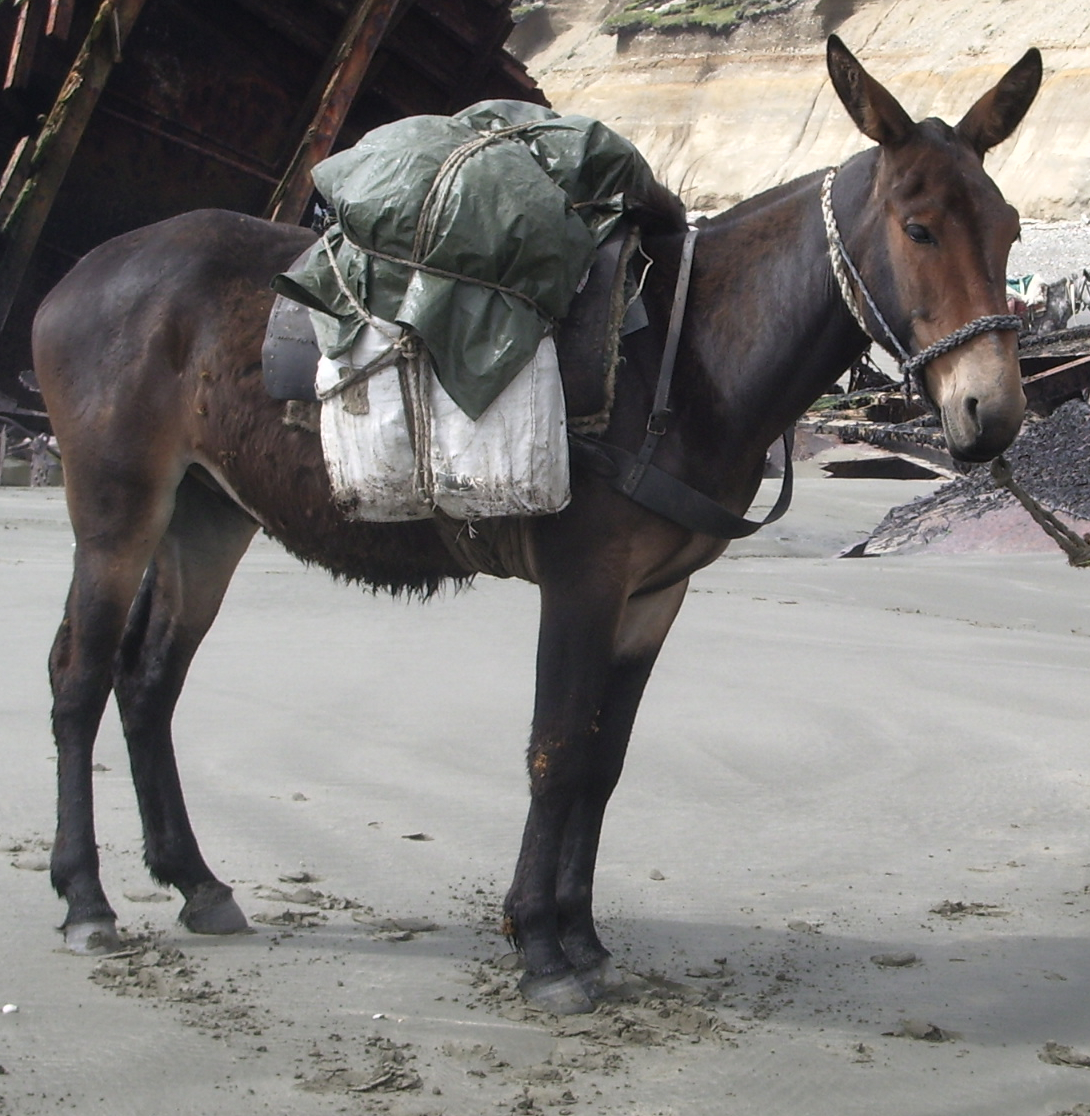
Hybrids are the offspring of two species. A mule is the hybrid offspring of a female horse and male donkey. Because mules are sterile, they are not classified as a distinct species.
Image credit: Juancito by Dario u, public domain
The biological species concept connects the idea of a species to the process of evolution. Because members of a species can interbreed, the species as a whole has a common gene pool, a collection of gene variants.
On the other hand, genes are not exchanged between different species. Even if organisms of different species combine their DNA to make offspring, the offspring will be sterile, unable to pass on their genes. Because of this restricted gene flow, each species evolves as a group distinct from other species.
[Are there other species concepts?]
What keeps species distinct?
The biological species concept defines organisms as being, or not being, of the same species based on whether they can interbreed to make fertile offspring. But why is it that different species can't successfully interbreed? This question may seem silly for very different species (like a plant and an animal), but for others like the horse and the donkey above, it's much less obvious.
Broadly speaking, different species are unable to interbreed and produce healthy, fertile offspring due to barriers called mechanisms of reproductive isolation.
These barriers can be split into two categories based on when they act: prezygotic and postzygotic.
Prezygotic barriers
Prezygotic barriers prevent members of different species from mating to produce a zygote, a single-celled embryo. Some example scenarios are below:
- Two species might prefer different habitats and thus be unlikely to encounter one another. This is called habitat isolation. [May I see an example?]
- Two species might reproduce at different times of the day or year and thus be unlikely to meet up when seeking mates. This is called temporal isolation. [May I see an example?]
- Two species might have different courtship behaviors or mate preferences and thus find each other "unattractive". This is known as behavioral isolation. [May I see an example?]
- Two species might produce egg and sperm cells that can't combine in fertilization, even if they meet up through mating. This is known as gametic isolation. [May I see an example?]
- Two species might have bodies or reproductive structures that simply don't fit together. This is called mechanical isolation. [May I see an example?]
These are all examples of prezygotic barriers because they prevent a hybrid zygote from ever forming.
Postzygotic barriers
Postzygotic barriers keep hybrid zygotes—one-celled embryos with parents of two different species—from developing into healthy, fertile adults. Postzygotic barriers are often related to the hybrid embryo's mixed set of chromosomes, which may not match up correctly or carry a complete set of information.
In some cases, the chromosomal mismatch is lethal to the embryo or results in an individual that can survive but is unhealthy. In other cases, a hybrid can survive to adulthood in good health but is infertile because it can't split its mismatched chromosomes evenly into eggs and sperm. For example, this type of mismatch explains why mules are sterile, unable to reproduce^44start superscript, 4, end superscript.
Prezygotic and postzygotic barriers not only keep species distinct, but also play a role in the formation of new species, as we'll see next.
How do new species arise?
New species arise through a process called speciation. In speciation, an ancestral species splits into two or more descendant species that are genetically different from one another and can no longer interbreed.
Darwin envisioned speciation as a branching event. In fact, he considered it so important that he depicted it in the only illustration of his famous book, On the Origin of Species, below left. A modern representation of Darwin's idea is shown in the evolutionary tree of elephants and their relatives, below right, which reconstructs speciation events during the evolution of this group.
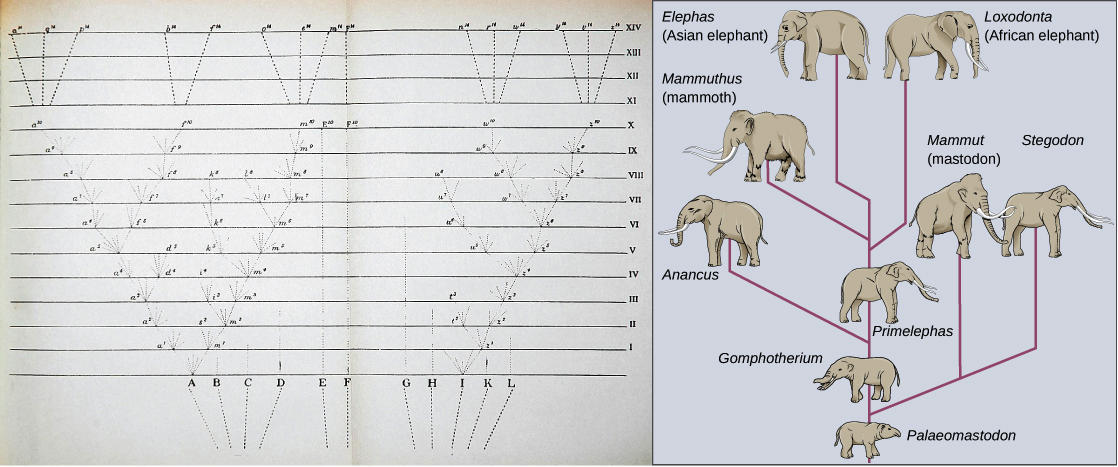
Image credit: Formation of new species: Figure 3 by OpenStax College, Biology, CC BY 4.0
For speciation to occur, two new populations must be formed from one original population, and they must evolve in such a way that it becomes impossible for individuals from the two new populations to interbreed. Biologists often divide the ways that speciation can occur into two broad categories:
- Allopatric speciation—allo meaning other and patric meaning homeland—involves geographic separation of populations from a parent species and subsequent evolution.
- Sympatric speciation—sym meaning same and patric meaning homeland—involves speciation occurring within a parent species remaining in one location.
Let's take a closer look at these forms of speciation and how they work.
Allopatric speciation
In allopatric speciation, organisms of an ancestral species evolve into two or more descendant species after a period of physical separation caused by a geographic barrier, such as a mountain range, rockslide, or river.
Sometimes barriers, such as a lava flow, split populations by changing the landscape. Other times, populations become separated after some members cross a pre-existing barrier. For example, members of a mainland population may become isolated on an island if they float over on a piece of debris.
Once the groups are reproductively isolated, they may undergo genetic divergence. That is, they may gradually become more and more different in their genetic makeup and heritable features over many generations. Genetic divergence happens because of natural selection, which may favor different traits in each environment, and other evolutionary forces like genetic drift.
As they diverge, the groups may evolve traits that act as prezygotic and/or postzygotic barriers to reproduction. For instance, if one group evolves large body size and the other evolves small body size, the organisms may not be physically able to mate—a prezygotic barrier—if the populations are reunited.
If the reproductive barriers that have arisen are strong—effectively preventing gene flow—the groups will keep evolving along separate paths. That is, they won't exchange genes with one another even if the geographical barrier is removed. At this point, the groups can be considered separate species.
Case study: squirrels and the Grand Canyon
The Grand Canyon was gradually carved out by the Colorado River over millions of years. Before it formed, only one species of squirrel inhabited the area. As the canyon got deeper over time, it became increasingly difficult for squirrels to travel between the north and south sides.

The Grand Canyon in Arizona was gradually carved out by the Colorado River over millions of years. As the canyon deepened, it acted as geographic barrier to squirrel populations on either side. Two squirrel species evolved as a result of allopatric speciation.
Image credit: Toroweap sunrise by John Fowler, CC BY 2.0
Eventually, the canyon became too deep for the squirrels to cross and a subgroup of squirrels became isolated on each side. Because the squirrels on the north and south sides were reproductively isolated from one another due to the deep canyon barrier, they eventually diverged into different species^55start superscript, 5, end superscript.
![]()
Harris's antelope squirrel evolved on the south side of the Grand Canyon as a result of allopatric speciation.
The white-tailed antelope squirrel evolved on the north side of the Grand Canyon as a result of allopatric speciation.
Image credit: left, image modified from Ammospermophilus harrisii by Ryan Johnston, CC BY 2.0; right, image modified from Ammospermophilus leucurus by Jarek Tuszynski, CC BY-SA 3.0
Sympatric speciation
In sympatric speciation, organisms from the same ancestral species become reproductively isolated and diverge without any physical separation.
At first, this idea may seem kind of weird, especially after thinking about allopatric speciation. Why would groups of organisms in a population stop interbreeding when they still live in the same place?
There are several ways that sympatric speciation can happen. However, one mechanism that's quite common—in plants, that is!—involves chromosome separation errors during cell division. Let's take a closer look at this process.
Polyploidy
Polyploidy is the condition of having more than two full sets of chromosomes. Unlike humans and other animals, plants are often tolerant of changes in their number of chromosome sets, and an increase in chromosome sets, a.k.a. ploidy, can be an instant recipe for plant sympatric speciation.
How could polyploidy lead to speciation? As an example, let’s consider the case where a tetraploid plant—4n, having four chromosome sets—suddenly pops up in a diploid population—2n, having two chromosome sets.
Such a tetraploid plant might arise if chromosome separation errors in meiosis produced a diploid egg and a diploid sperm that then met up to make a tetraploid zygote. This process is shown in a general schematic below, but if you'd like to know more about how the separation errors could actually happen, you can learn more in the nondisjunction article.
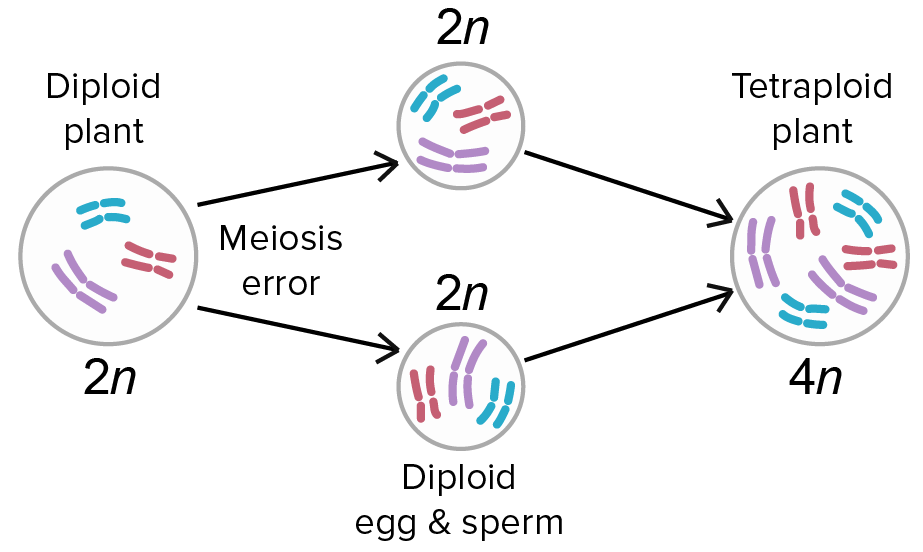
Image credit: modified from Polyploidization by Ilmari Karonen, public domain
When the tetraploid plant matures, it will make diploid, 2n, eggs and sperm. These eggs and sperm can readily combine with other diploid eggs and sperm via self-fertilization, which is common in plants, to make more tetraploids.
On the other hand, the diploid eggs and sperm may or may not combine effectively with the haploid, 1n, eggs and sperm from the parental species. Even if the diploid and haploid gametes do get together to produce a triploid plant with three chromosome sets, this plant would likely be sterile because its three chromosome sets could not pair up properly during meiosis.
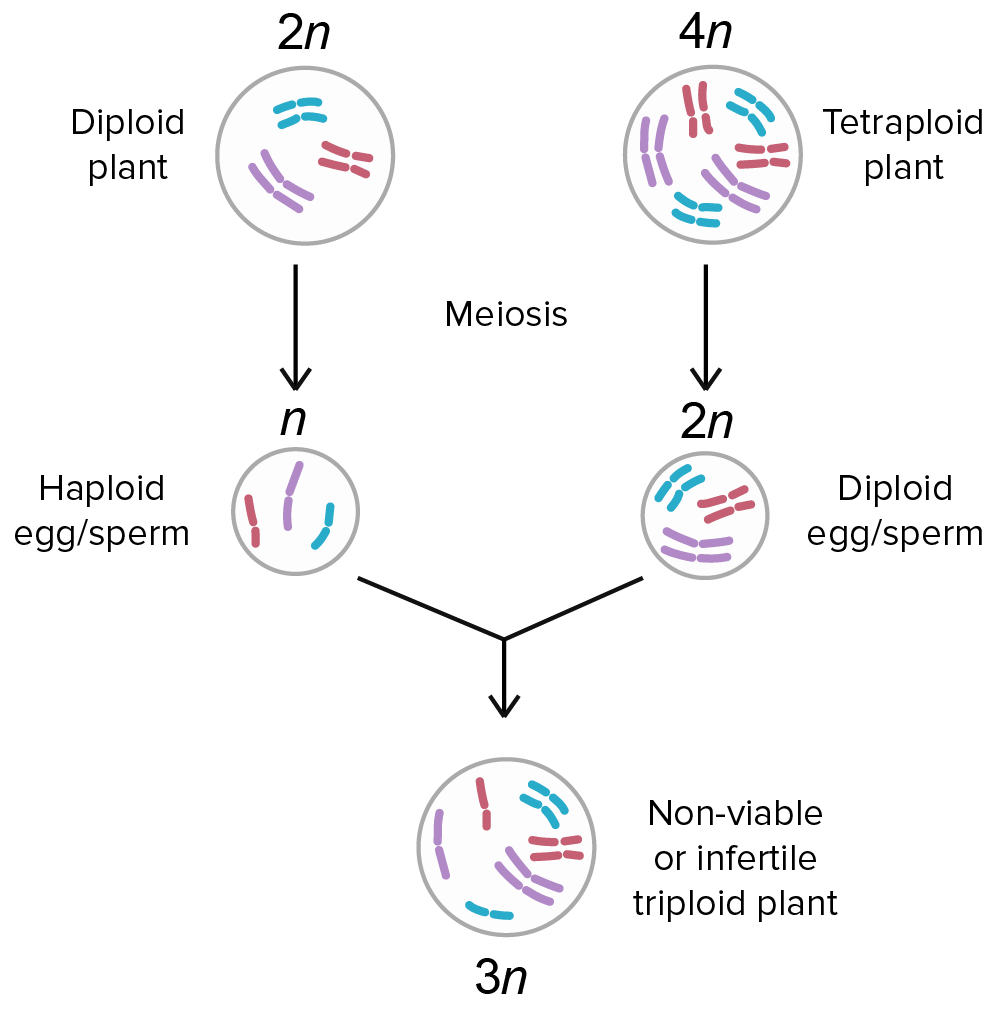
Image credit: modified from Polyploidization by Ilmari Karonen, public domain
Because the tetraploid plants and the diploid species from which they came cannot produce fertile offspring together, we consider them two separate species. This means that speciation occurred after just a single generation!
Speciation by polyploidy is common in plants but rare in animals. In general, animal species are much less likely to tolerate changes in ploidy. For instance, human embryos that are triploid or tetraploid are non-viable—they cannot survive.
[Need to know about autopolyploidy and allopolyploidy?]
Sympatric speciation without polyploidy
Can sympatric speciation, speciation without geographical separation, occur by mechanisms other than polyploidy? There’s some debate about how important or common a mechanism it is, but the answer appears to be yes, at least in some cases. For instance, sympatric speciation may take place when subgroups in a population use different habitats or resources, even though those habitats or resources are in the same geographical area.
One classic example is the North American apple maggot fly. As the name suggests, North American apple maggot flies, like the one pictured below, can feed and mate on apple trees. The original host plant of these flies, however, was the hawthorn tree. It was only when European settlers introduced apple trees about 200 years ago that some flies in the population started to exploit apples as a food source instead^{6,7}6,7start superscript, 6, comma, 7, end superscript.
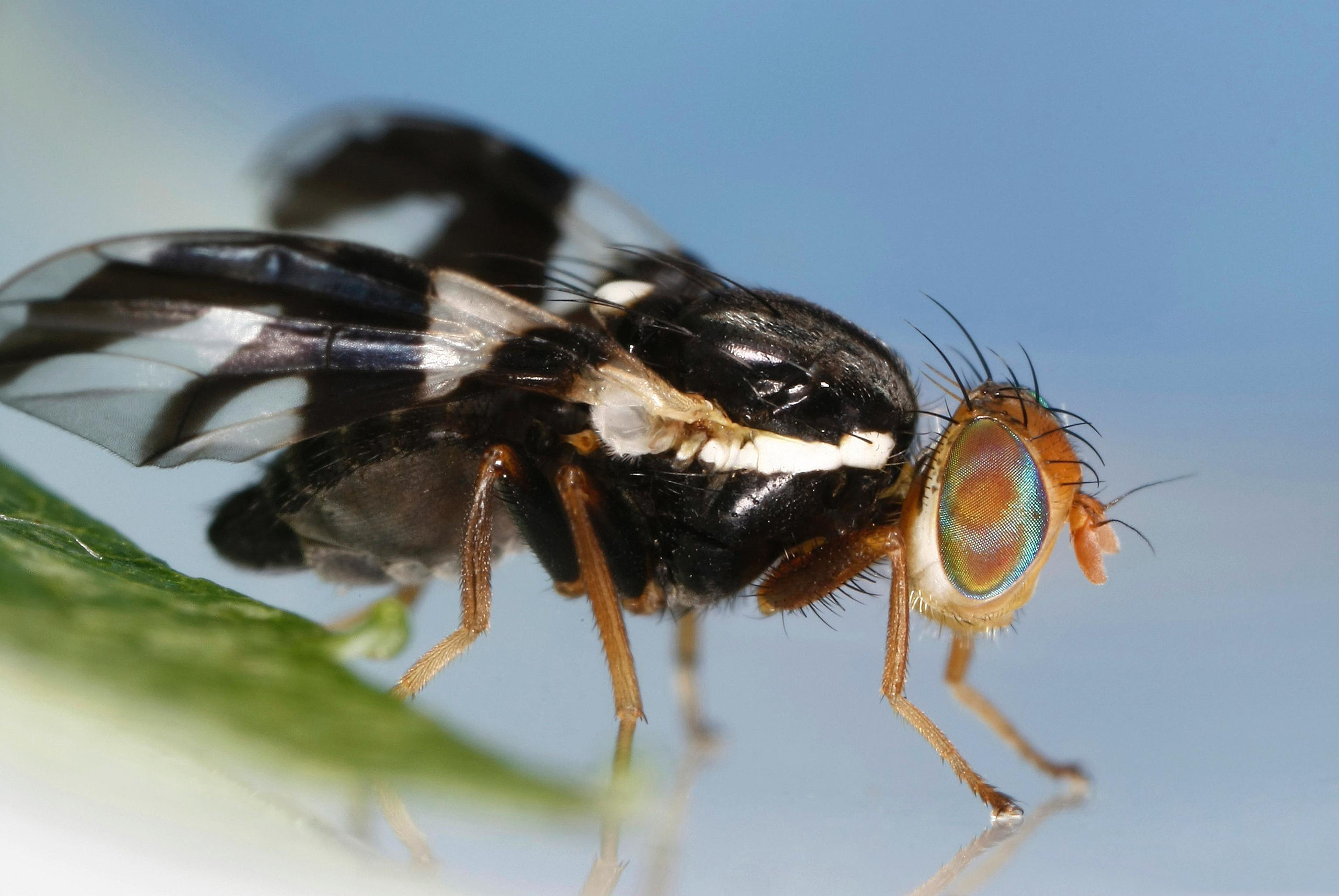
The apple maggot fly is thought to have evolved through sympatric speciation from its ancestor, the North American maggot fly. This example of sympatric speciation occurred through habitat differentiation: apple maggot flies began to prefer apple trees as host plants, whereas their ancestors used hawthorn trees.
Image credit: Rhagoletis pomonella.jpg by Joseph Berger, CC BY 3.0
The flies that were born in apples tended to feed on apples and mate with other flies on apples, while the flies born on hawthorns tended to similarly stick with hawthorns^77start superscript, 7, end superscript. In this way, the population was effectively divided into two groups with limited gene flow between them, even though there was no reason an apple fly couldn't go over to a hawthorne tree, or vice versa.
Over time, the population diverged into two genetically distinct groups with adaptations, features arising by natural selection, that were specific for apple and hawthorne fruits. For instance, the apple and hawthorne flies emerge at different times of year, and this genetically specified difference synchronizes them with the emergence date of the fruit on which they live^{8,9}8,9start superscript, 8, comma, 9, end superscript.
Some interbreeding still occurs between the apple-specialized flies and the hawthorne-specialized flies, so they are not yet separate species. However, many scientists think this is a case of sympatric speciation in progress.
Summary
The biological species concept defines a species as a group of individuals living in one or more populations that can potentially interbreed to produce healthy, fertile offspring. Other species concepts exist and may be more useful for certain types of organisms.
Species are kept distinct from one another by prezygotic and postzygotic barriers. These barriers keep organisms of different species from mating to produce fertile offspring, acting before and after the formation of a zygote, respectively. These barriers maintain the reproductive isolation of species.
New species form by speciation, in which an ancestral population splits into two or more genetically distinct descendant populations. Speciation involves reproductive isolation of groups within the original population and accumulation of genetic differences between the two groups.
In allopatric speciation, groups become reproductively isolated and diverge due to a geographical barrier. In sympatric speciation, reproductive isolation and divergence occur without geographical barriers—for example, by polyploidy.